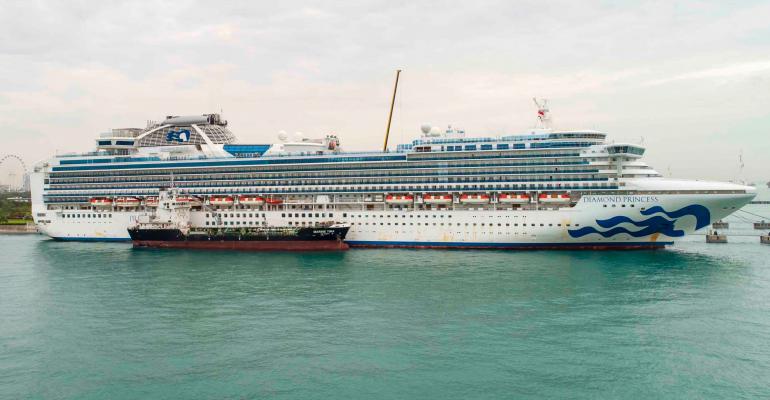CDC said available statistical models of the Diamond Princess outbreak suggest that 17.9% of infected persons never developed symptoms.
Tracing the spread
In an analysis of the Diamond Princess and Grand Princess cases, the CDC traced how the infection spread, and said SARS-CoV-2 RNA was identified on a variety of surfaces in cabins of both symptomatic and asymptomatic infected passengers up to 17 days after cabins were vacated on Diamond Princess before disinfection procedures were conducted.
RNA, short for ribonucleic acid, is material that carries the genetic information of many viruses. It can indicate if the virus was present but does not indicate the virus was still alive.
'Although these data cannot be used to determine whether transmission occurred from contaminated surfaces, further study of fomite transmission of SARS-CoV-2 aboard cruise ships is warranted,' CDC said. 'Fomite' refers to objects that may be contaminated with infectious organisms and serve in their transmission.
Three cruises, more than 800 cases, 10 deaths
According to CDC, COVID-19 outbreaks associated with three cruise ship voyages resulted in more than 800 laboratory-confirmed cases among passengers and crew, including 10 deaths, with transmission occurring across multiple voyages of several ships.
To recap, during Feb. 7-23, the largest cluster of cases outside mainland China occurred on Diamond Princess, which was quarantined in Yokohama Feb. 3. On March 6, cases were identified on Grand Princess off the coast of California; that ship was subsequently quarantined. By March 17, confirmed cases of COVID-19 had been associated with at least 25 additional cruise ship voyages.
On Feb. 21, CDC recommended avoiding travel on cruise ships in Southeast Asia; on March 8, this was broadened to include deferring all cruise ship travel worldwide for those with underlying health conditions and for people 65 and older. On March 13, Cruise Lines International Association announced a 30-day voluntary suspension of cruise operations in the United States. CDC issued a level 3 travel warning on March 17, recommending that all cruise travel be deferred worldwide.
Transmissions
On Diamond Princess, transmission largely occurred among passengers before quarantine was implemented, whereas crew infections peaked after quarantine. On Grand Princess, crew were likely infected on a first voyage and then transmitted the virus to passengers on a second voyage, CDC said.
Diamond Princess
On Jan. 20, Diamond Princess departed Yokohama, carrying approximately 3,700 passengers and crew. Five days later, a symptomatic passenger left the ship in Hong Kong, where he tested positive. On Feb. 3, the ship returned to Japan, after making six stops in three countries. Japanese authorities were notified of the COVID-19 diagnosis in the passenger who disembarked in Hong Kong, and the ship was quarantined. Information about social distancing and monitoring of symptoms was communicated to passengers.
On Feb. 5, passengers were quarantined in their cabins; crew continued to work and, therefore, could not be isolated. As Japanese health officials subsequently acknowledged, this was a mistake in their direction of the quarantine.
Ultimately, among 3,711 Diamond Princess passengers and crew, 712 (19.2%) had positive test results. Of these, 331 (46.5%) were asymptomatic at the time of testing. Among 381 symptomatic patients, 37 (9.7%) required intensive care, and nine (1.3%) died. Infections also occurred among three Japanese responders, including one nurse, one quarantine officer and one administrative officer. As of March 13, among 428 US passengers and crew, 107 (25%) had positive test results. Eleven US passengers remain hospitalized in Japan (their median age is 75), including seven in serious condition.
Grand Princess
During Feb. 11-21, Grand Princess sailed round-trip from San Francisco, making four stops in Mexico. Most of the 1,111 crew and 68 passengers from this cruise remained on board for a second voyage that departed San Francisco on Feb. 21, with a planned return on March 7.
On March 4, a clinician in California reported two patients with COVID-19 symptoms who had traveled on the first voyage, one with positive results. CDC notified the cruise line, which began canceling group activities. More than 20 additional cases among persons who did not travel on the second cruise were identified from the first cruise, the majority in California. One death has been reported.
On March 5, a response team was transported by helicopter to the ship to collect specimens from 45 passengers and crew with respiratory symptoms; 21 (46.7%), including two passengers and 19 crew, tested positive. Passengers and symptomatic crew were asked to self-quarantine in their cabins, and room service replaced public dining until disembarkation. Following docking in Oakland, California, on March 8, passengers and crew were transferred to land-based sites for a 14-day quarantine period or isolation.
During land-based quarantine in the United States, all persons were offered testing. As of March 21, of 469 people with available test results, 78 (16.6%) were positive.
The full CDC report is here.
Copyright © 2024. All rights reserved. Seatrade, a trading name of Informa Markets (UK) Limited.
Add Seatrade Cruise News to your Google News feed.  |

